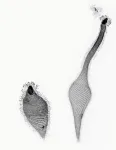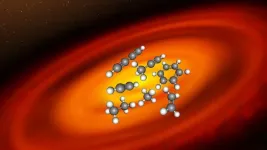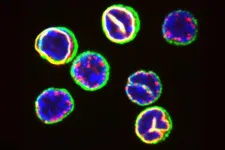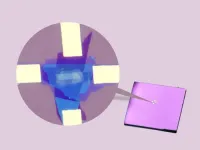(Press-News.org) For a tiny hunter of the microbial world that relies on extending its neck up to 30 times its body length to release its deadly attack, intricate origami-like cellular geometry is key. This geometry enables the rapid hyperextensibility of the neck-like protrusion, for single-celled predator Lacrymaria olor, a new study reports. The findings not only explain L. olor’s extreme shape-shifting ability but also hold potential for inspiring innovations in soft-matter engineering or the design of robotic systems. Single-celled protists are well known for their ability to perform dynamic morphological changes in real time, including large transformations in cell architecture. These organisms undergo large strains and strain rates to accomplish such feats. One such protist, L. olor,extends a neck-like protrusion to catch prey at a distance. This tiny, 40-micron single-celled creature can repeatedly stretch this protrusion up to 1200 microns in less than 30 seconds and then retract it just as quickly. However, the underlying mechanisms that produce L. olor’s extreme hyperextensibility remain unknown. To observe these mechanics at the sub-cellular level, Eliott Flaum and Manu Prakash used a combination of live imaging, confocal, and transmission electron microscopy. They discovered that an origami-like layered cortical cytoskeleton and membrane architecture enables L. olor’s rapid extension and contraction. According to the findings, the cell membrane is folded into 15 contagious pleats that, together, form a curved-crease origami that can sequentially unspool for rapid and repeatable hyper-extensions of the neck. This intricate folding scheme is scaffolded on a helicoidal structure of microtubule filaments that guides the membrane creases to ensure fast and efficient unfolding and refolding during shape changes. To better understand the dynamics involved, Flaum and Prakash developed a mechanical paper model that mimics L. olor’s curved crease origami architecture. In a Perspective, Leonardo Gordillo and Enrique Cerda discuss the findings in greater detail.
END
Tiny predator owes its shape-shifting ability to “origami-like” cellular architecture
2024-06-06
ELSE PRESS RELEASES FROM THIS DATE:
Widespread use of high-assay low-enriched uranium raises significant nuclear security concerns
2024-06-06
In a Policy Forum, R. Scott Kemp and colleagues argue that promoting new nuclear reactor technologies using high-assay low-enriched uranium (HALEU) threatens the international system of controls that has prevented nuclear weapons proliferation for over 30 years. “Governments and others promoting the use of HALEU have not carefully considered the potential proliferation and terrorism risks that the wide adoption of this fuel creates,” write Kemp et al. The authors warn that if HALEU becomes a standard reactor ...
JWST uncovers features of very-low-mass star’s protoplanetary disk that influence planet composition
2024-06-06
James Webb Space Telescope (JWST) observations have revealed abundant hydrocarbons in the protoplanetary disk surrounding a young, very-low-mass star – findings that provide novel insights into the chemical environment from which many terrestrial planets, in particular, are born. Planets form in disks of gas and dust that orbit young stars. Observations show that terrestrial planets form more efficiently than gas giant planets around very-low-mass stars (VLMSs) – those with less than 0.3 solar masses. Although the chemical compositions of the inner disk regions around higher mass stars ...
Mammalian adipose tissue thermogenesis evolved in eutherian mammals
2024-06-06
Heat production in fat tissue, a trait also known as adipose tissue thermogenesis, evolved over two stages in mammals, fully developing in eutherian mammals after the group’s evolutionary divergence from marsupials, according to a new study. The results could provide insights that inform future therapies related to metabolism and obesity. Many organisms produce heat internally to regulate body temperature. It is thought that the evolution of the ability to maintain high body temperatures provided ...
The first example of cellular origami
2024-06-06
“There are some things in life you can watch and then never unwatch,” said Manu Prakash, associate professor of bioengineering at Stanford University, calling up a video of his latest fascination, the single-cell organism Lacrymaria olor, a free-living protist he stumbled upon playing with his paper Foldscope. “It’s … just … it’s mesmerizing.”
“From the minute Manu showed it to me, I have just been transfixed by this cell,” said Eliott Flaum, a graduate student ...
Planet-forming disks around very low-mass stars are different
2024-06-06
Planets form in disks of gas and dust, orbiting young stars. The MIRI Mid-INfrared Disk Survey (MINDS), led by Thomas Henning from the Max Planck Institute for Astronomy (MPIA) in Heidelberg, Germany, aims to establish a representative disk sample. By exploring their chemistry and physical properties with MIRI (Mid-Infrared Instrument) on board the James Webb Space Telescope (JWST), the collaboration links those disks to the properties of planets potentially forming there. In a new study, a team of researchers ...
Researchers identify key differences in inner workings of immune cells
2024-06-06
From the outside, most T cells look the same: small and spherical. Now, a team of researchers led by Berend Snijder from the Institute of Molecular Systems Biology at ETH Zurich has taken a closer look inside these cells using advanced techniques. Their findings show that the subcellular spatial organisation of cytotoxic T cells – which Snijder refers to as their cellular architecture – has a major influence on their fate.
Characteristics that determine a cell’s fate
When cells with nuclear invaginations encounter a pathogen, they turn into powerful effector cells that rapidly proliferate and kill the pathogen. Their fellow ...
Molecular pathway that impacts pancreatic cancer progression and response to treatment detailed
2024-06-06
CHAPEL HILL, North Carolina – Researchers at UNC Lineberger Comprehensive Cancer Center and colleagues have established the most comprehensive molecular portrait of the workings of KRAS, a key cancer-causing gene or "oncogene," and how its activities impact pancreatic cancer outcomes. Their findings could help to better inform treatment options for pancreatic cancer, which is the third leading cause of all cancer deaths in the United States.
The research was published as two separate articles in Science.
“Because ...
Ferroelectric material is now fatigue-free
2024-06-06
Researchers at the Ningbo Institute of Materials Technology and Engineering (NIMTE) of the Chinese Academy of Sciences, in collaboration with research groups from the University of Electronic Science and Technology of China and Fudan University, have developed a fatigue-free ferroelectric material based on sliding ferroelectricity.
The study was published in Science.
Ferroelectric materials have switchable spontaneous polarization that can be reversed by an external electric field, which have been widely applied to non-volatile memory, sensing, and ...
Marsupials key to discovering the origin of heater organs in mammals
2024-06-06
Around 100 million years ago, a remarkable evolutionary shift allowed placental mammals to diversify and conquer many cold regions of our planet. New research from Stockholm University shows that the typical mammalian heater organ, brown fat, evolved exclusively in modern placental mammals.
In collaboration with the Helmholtz Munich and the Natural History Museum Berlin in Germany, and the University of East Anglia in the U.K., the Stockholm research team demonstrated that marsupials, our distant relatives, possess a not fully evolved form of brown fat. They discovered that the pivotal heat-producing protein called ...
Epstein-Barr Virus and brain cross-reactivity: possible mechanism for Multiple Sclerosis
2024-06-06
The role that Epstein-Barr Virus (EBV) plays in the development of multiple sclerosis (MS) may be caused a higher level of cross-reactivity, where the body’s immune system binds to the wrong target, than previously thought.
In a new study published in PLOS Pathogens, researchers looked at blood samples from people with multiple sclerosis, as well as healthy people infected with EBV and people recovering from glandular fever caused by recent EBV infection. The study investigated how the immune system deals with EBV infection as part of worldwide efforts to understand how this common virus can lead to the development of multiple ...





